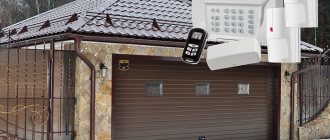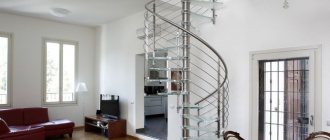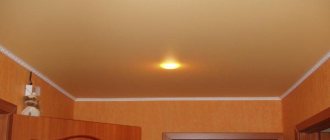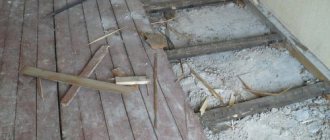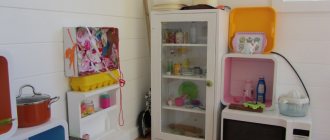A decorative fence with your own hands will help decorate your garden plot and give your flower beds and flower beds a complete, original look. Fences for flower beds can not only transform the landscape of the garden, but also perform other useful functions:
- Aesthetics.
Flower beds and flower beds bordered by a decorative fence look neat and beautiful. Plastic decorative fence for a garden flower bed - Zoning the territory and creating a unified style on the site.
- Plant growth inhibition. Flowers grow within established boundaries.
- Plant protection. Fences help protect garden plantings from accidental damage and trampling by pets.
- A fenced flower garden or flower bed is easier to care for.
Depending on the purpose of the fence, the type of plants, as well as the overall design of the garden, the height and design of the fence are selected:
- A low fence between the flowers and the lawn will fully cope with its barrier function.
- A higher fence is needed to protect flower beds from small children and pets; the height of the fence starts from 40 cm.
- Burying the fence into the ground is necessary for plants that reproduce by root suckers. A fence dug into the ground will also rid the flower garden of weeds.
- A raised fence should be made of durable materials that can support the weight of overhanging plants.
An example of a raised decorative fence for a flower bed
The range of ready-made garden fencing is very large. However, if you show a little imagination, a decorative fence made by yourself can please you even more than the most beautiful modern products. There are practically no restrictions on the options for making fences for flower beds. Let's consider the simplest options from traditional and not so traditional materials.
Return to contents
Wooden fences
Wood is a classic option, the most affordable and in demand. In addition, it is one hundred percent environmentally friendly material that will not harm plants or the earth. On the contrary, slowly decomposing wood will nourish the soil and plants.
Decorative fence for a flower bed made of sawn logs
To decorate flower beds and flower beds with wooden fences, you can use boards, beams, small stumps, stakes, twigs, bars, saw cuts, etc.
Return to contents
Types of wooden fences
- Low picket fence front garden. For the fencing you will need cutting boards or picket fences, bars with a small cross-section, and support posts. Installation is simple - the pillars are dug in around the perimeter of the flowerbed, bars or boards are nailed to them horizontally, and the picket fence itself, previously sawn to the required length, is installed. The finished flower bed can be painted any color. Instead of a picket fence, you can use the remains of the lining;
- A fence made of chocks. Let's look at how to make a decorative fence from thin logs. Chocks can be installed exactly along one line or have different heights, which looks very interesting. The logs can be sharpened and driven into the ground, or placed in a dug trench and compacted well. When cutting chocks, it should be taken into account that about 20 cm will remain underground.
The finished fence can be painted or left in its natural form.
Important! The wood must be treated with an antiseptic, especially the parts in contact with the ground, so the decorative fence will last longer.
Return to contents
How to extend the service life of the material
Many people refuse a wooden fence precisely because it is one of the most fragile materials that quickly loses its original appearance. However, proper treatment will extend the life of a wooden fence for many years. Another advantage is the low price. Installing a brick fence is quite expensive, despite its reliability. Wood combines the positive qualities of other materials, and is very inexpensive.
Wood is a beautiful and inexpensive material
First of all, the species with the densest wood that is resistant to various adverse effects are selected:
- pine,
- larch,
- oak,
- alder,
- ash.
Birch is completely unsuitable for this task: its wood is loose and very fragile. A larch fence, on the contrary, can stand almost forever, since water not only does not destroy it, but, on the contrary, strengthens it.
Even before installation, the wood must be impregnated with special antiseptic compounds that prevent rotting. After installation, the fence will have to be painted to prevent water from damaging the wood.
Wicker fences
Wicker flower beds and fences for the garden fit organically into the rustic style, and the plants in such flower beds look especially cute. The work itself of creating a wicker fence with your own hands will bring a lot of pleasure. To work you will need any flexible branches:
- and you;
- hazel;
- willows;
- grape vines;
- raspberries;
- cherries.
An example of a wicker fence for a summer house
It is best to prepare material for wicker flower beds in early spring; at this time, the rods have good flexibility and are better cleared of bark. If the branches are not flexible enough, they are soaked in hot water.
Return to contents
Wicker fence installation
- Along the perimeter of the fence, stakes of the required height and the same diameter are driven in. In order for the fence to be more durable, the distance between the supports should not be too large.
- The branches go around the pegs in alternation: if one pole is braided from the outside, then the next one is braided from the inside. It is better to weave from the end of the fence where the beginning of the work will be less noticeable. Weaving the second row is done in reverse; if the column is braided on the outside, the next branch should be on the inside. Each row is tapped with a hammer.
The process of making a section of wicker fence
- The branches at the ends of the fence are nailed to the supports with small nails. The lower and upper branches are tied to the supports with wire for reliability. This way the lower rod will not fall down and the upper rod will not jump out of the fence.
Tip: when weaving, you can take branches one at a time or several at a time. Very thin branches are often woven into bunches to create a beautiful chess pattern.
Wicker fences for flowers can be made in the form of a border, a fairly high fence, or in the shape of a basket. You can make a raised flower bed out of wattle fence. To do this, the sides of the flowerbed need to be protected with plastic film, drainage in the form of crushed stone and sand should be placed on the bottom and soil should be poured.
Return to contents
Material selection
To build a fence you will need the following materials:
- boards;
- bars.
Before you begin, pay attention to the choice of building materials. It is best to buy dense, high-quality wood; oak and aspen are perfect for building a fence. Strong fences around the house can be made of ash and Siberian larch; fences made of alder and mulberry look beautiful. You can decide on a project by studying photos of fences.
Siberian larch is considered one of the most interesting options. A fence around the house made from this material will last as long as possible. The fact is that moisture quickly spoils wood, and larch, in contact with water, only increases its strength.
It is better to use pine lumber for making fence panels. When it wears out, you can easily replace parts of the fence at your dacha. There will be no special financial costs, because pine lumber is cheap. Do not buy birch for construction: its wood quickly deteriorates under the influence of natural factors.
Making a wooden fence with your own hands is quite easy. Select the material for the supports, install metal pillars. Wooden ones are dug into the ground only after processing, or they are attached to special metal consoles, which are pre-concreted in the recesses.
Be sure to use antiseptics, they will reduce the impact of moisture and prevent the appearance of fungus. In order to consolidate the effect, treat the lumber with a special dye. For example, Swedish paint will give the boards a beautiful shade. If you wish, you can apply dye to the picket fence, but in a different color.
Brick fence
Brick as borders for flower beds in the garden is one of the popular options. The design of a brick fence can be very different. There are many advantages to such a fence:
- Attractiveness. Unless, of course, it’s not an old crumbling brick, but, for example, a solid colored version;
- A brick border looks organically with the brick walls of the house and plants;
- Strength. The brick curb is durable even without the use of cement;
- A brick dug into the ground protects flower beds well from weeds.
Return to contents
DIY brick flowerbed border
- Marking. The contour of a brick flower bed can be anything: straight, round, concave, with bends.
- Preparing the trench. A shallow ditch is dug along the perimeter of the flower bed, about 15 cm deep and about 25 cm wide.
- Installing a flowerbed border. Brickwork is laid, secured with cement mortar. You can lay out bricks in different ways; the main thing is to ensure the strength and evenness of the fence.
- The solution should dry within 3 - 5 days and the flower garden can be used for its intended purpose.
The process of making a brick flower bed
Return to contents
Decorative fences made of natural stone
Garden fencing made of natural stone is beauty, harmony and durability. You can create beautiful flower beds and flower beds from natural materials. You can use any mineral for a garden fence: pebbles, granite, sandstone, dolomite, marble. You can make the following types of decorative fencing with your own hands from stone:
- Simple laying in one row. The easiest way to arrange flower beds is to lay stone around the perimeter of the fence.
- Laying in several rows. To get a tall and more noticeable flower bed made of stone, it can be laid in several rows. It is more convenient to use flat slate for work. A trench is dug under the base of the stone fence, which can be filled with cement to create a small foundation. The stone is laid using cement. To make the masonry even, you need to mark the place of the flower bed and stretch the guide twine.
The process of laying a stone fence for a flower bed
Usually the stones are fastened with cement closer to the inside of the fence, so that the effect of dry masonry without mortar remains on the outside.
- Spiral flower bed made of stone. A multi-tiered spiral flowerbed is an interesting solution for the garden. Gradually adding soil, the stones are laid out so that the highest point is formed in the center of the round flowerbed. At the top of such a flower bed, heat-loving flowers will feel good.
Return to contents
Types of decorative wooden fencing
The most popular types of fences are:
- Solid board fence. Ordinary boards are used, which are tightly packed onto the transverse joists.
- Palisade fence. Solid trunks or rounded logs with a pointed top are arranged vertically.
- Herringbone, ladder or blinds. The boards are overlapped or with gaps at an angle to each other.
- Ranch style fence. Massive boards nailed with large gaps.
Classic Wood Ranch Fence
- Lattice fence. Fence sections are made of wooden boards or slats connected into a lattice fabric.
- Checkerboard fence. It can be deaf and with a gap. In the first case, the gaps between vertically installed boards are closed with another row of boards. The option with a gap assumes that the boards on the reverse side are not nailed tightly. There remains a gap that allows light to pass through, but partially hides the area from prying eyes.
- Wicker of boards. You can weave an original decorative fence from the boards. Boards can be installed both horizontally and vertically.
- Wooden picket fence. Traditional version of a wooden fence. The boards are nailed to the joists vertically with gaps.
- Combined fence. Wooden spans are successfully combined with other materials. Pillars made of stone, concrete or brick will look natural with wooden spans.
Return to contents
Pergons and gabions
Natural stone in a welded mesh allows you to create flower beds and fences for a garden of any height. Multi-tiered or tall flower beds made from gabions look great in combination with the natural landscape.
Installing such a fence is also not difficult. You need to assemble a box from a welded mesh and fill it with any stone, the main thing is that the size of the backfill matches the mesh cells.
You can install a structure made of stone and mesh on any base. Rack rods with a diameter of about 8 mm are used as the base.
The grate can be made from galvanized steel rods with a cross-section of 5 mm. In addition to stone, other materials may be present in the structure: tree cuts, glass, brick, concrete. After installing the flowerbed, its walls are lined with geotextiles, and soil is poured into which flowers can be planted.
Return to contents
Garden fences made of corrugated sheets and slate
From the remnants of roofing materials, you can build quite a decent fence for flower beds and flower beds, which will cope well with its main tasks.
Installation of such a fence is as simple as possible:
- A narrow, shallow ditch is dug.
- Strong pegs or pieces of reinforcement are driven in along the perimeter of the fence.
An example of a slate fence for a garden bed or flower bed
- Sheet material is installed in the trench. In this case, the sheet should rest on the protruding bars. From corrugated sheet metal, which bends well, you can make curved flower beds.
- The trench is dug and the soil is compacted well.
Return to contents
Features of planting an elm hedge
Planting small-leaved elm has its own characteristics. It is possible to get a thick, dense fence; you just need to distribute the seedlings correctly. They can be located in one or two lines or in a checkerboard pattern. In this case, the seedlings are located at a distance of 0.5-1 meter from each other. If the distance is increased and the root system increases, the plant itself will also have a fairly large size. This is not the best thing when creating a living fence or border. If a living wall of elm is formed, then planting is carried out at a distance of 1.5-2 meters between individuals.
Before digging holes, markings are carried out. If the fence is planned to be made in a straight line, pegs are driven in at the corners of the area between which the thread is pulled. Pegs are driven in along the thread at a given distance. A hole or a trench doesn’t really matter. When the seedlings are located close together, it is preferable to form a trench; it is much easier to carry out work with it. The depth and width of the trench or hole directly depends on the size of the root system of the seedling. It should not be too small so as not to harm the young roots. Fertilizer is poured into the bottom of the finished trench. The root system of the seedling is covered with earth, compacted well in a circle. An obligatory completion is watering; it is necessary in copious quantities. This is the key to better adaptation of the young seedling.
During the first year, you should not form bushes by cutting them, especially if planting was done in the summer. Haircuts are carried out from the second year, several times per season. The shape and seating height are determined according to individual preferences and expert advice. It is possible to do the work yourself, or use an experienced specialist.
Green fence for the garden
Plants with a rigid crown that are easy to shape can be used as hedges in the country. Low borders for flower beds are formed from small-leaved, low-growing plants such as boxwood, rosemary, and shiny honeysuckle.
The advantage of such “green” fences is their absolute naturalness and harmony with the environment. Once a living flower bed has established itself, it is quite easy to care for. You just need to periodically trim the growing fence.
Return to contents
Rules for selecting plants for hedges
There are many plants for hedges. The choice depends on individual factors - region of residence, landing site, purpose of use. Hedges are formed from:
- Coniferous varieties;
- Leaf species.
Sometimes several varieties are combined at the same time. This will require experience and an understanding of what result will be obtained. When choosing a plant, you should pay attention to its main characteristics - growth rate, crown density, leaves (shape, period of falling), the presence of flowers or fruits. Knowing as much as possible, it is quite possible to imagine what the garden will look like at different times of the year. The specifics of care are also taken into account.
